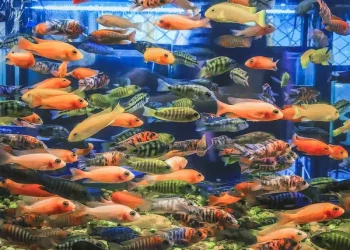The Australian Lungfish (Neoceratodus forsteri) is a unique freshwater fish found only in the Mary and Burnett River systems in Queensland, Australia. One of the most fascinating characteristics of this species is its ability to breathe air, which allows it to survive in low-oxygen environments and even stay out of water for extended periods of time. But can lungfish actually go on land?
The answer is yes, but with some caveats. While lungfish are not adapted to life on land, they can use their strong fins to wriggle and flop their way across short distances of damp mud, soil, or grass to reach new bodies of water or escape unfavorable conditions in their current habitat.
However, lungfish are not built for terrestrial movement and their bodies are not well-suited for extended periods of time out of water. Their skin is thin and sensitive, and can quickly dry out if exposed to air for too long. This can lead to dehydration, skin damage, and potentially fatal infections. Additionally, lungfish do not have the necessary musculature to support their weight on land, which can make movement on dry surfaces difficult and energy-intensive.
That being said, lungfish are capable of surviving out of water for short periods of time, such as during periods of drought or when their habitat dries up. They are known to burrow into mud or soil to escape the drying effects of the sun and wind, and can slow their metabolism and reduce their oxygen consumption to conserve energy.
One interesting adaptation that allows lungfish to breathe air is the presence of a modified swim bladder, which has evolved into a lung-like structure that allows them to extract oxygen from air. This adaptation is thought to have evolved as a survival strategy during times of low oxygen in water or when water levels receded, allowing lungfish to access new food sources or escape predators.
In conclusion, while lungfish are not adapted to life on land and cannot survive for extended periods of time out of water, they are capable of short bursts of movement across damp surfaces and can use their modified swim bladder to breathe air when necessary. Their unique adaptations and ability to breathe air have made them a fascinating and important species in the study of evolution and aquatic biology.


























